Huan Yang
Depatment of Gastroenterology, Second Affiliated Hospital, Army Medical University
Align-then-Slide: A complete evaluation framework for Ultra-Long Document-Level Machine Translation
Sep 04, 2025Abstract:Large language models (LLMs) have ushered in a new era for document-level machine translation (\textit{doc}-mt), yet their whole-document outputs challenge existing evaluation methods that assume sentence-by-sentence alignment. We introduce \textit{\textbf{Align-then-Slide}}, a complete evaluation framework for ultra-long doc-mt. In the Align stage, we automatically infer sentence-level source-target correspondences and rebuild the target to match the source sentence number, resolving omissions and many-to-one/one-to-many mappings. In the n-Chunk Sliding Evaluate stage, we calculate averaged metric scores under 1-, 2-, 3- and 4-chunk for multi-granularity assessment. Experiments on the WMT benchmark show a Pearson correlation of 0.929 between our method with expert MQM rankings. On a newly curated real-world test set, our method again aligns closely with human judgments. Furthermore, preference data produced by Align-then-Slide enables effective CPO training and its direct use as a reward model for GRPO, both yielding translations preferred over a vanilla SFT baseline. The results validate our framework as an accurate, robust, and actionable evaluation tool for doc-mt systems.
Mod-Adapter: Tuning-Free and Versatile Multi-concept Personalization via Modulation Adapter
May 24, 2025Abstract:Personalized text-to-image generation aims to synthesize images of user-provided concepts in diverse contexts. Despite recent progress in multi-concept personalization, most are limited to object concepts and struggle to customize abstract concepts (e.g., pose, lighting). Some methods have begun exploring multi-concept personalization supporting abstract concepts, but they require test-time fine-tuning for each new concept, which is time-consuming and prone to overfitting on limited training images. In this work, we propose a novel tuning-free method for multi-concept personalization that can effectively customize both object and abstract concepts without test-time fine-tuning. Our method builds upon the modulation mechanism in pretrained Diffusion Transformers (DiTs) model, leveraging the localized and semantically meaningful properties of the modulation space. Specifically, we propose a novel module, Mod-Adapter, to predict concept-specific modulation direction for the modulation process of concept-related text tokens. It incorporates vision-language cross-attention for extracting concept visual features, and Mixture-of-Experts (MoE) layers that adaptively map the concept features into the modulation space. Furthermore, to mitigate the training difficulty caused by the large gap between the concept image space and the modulation space, we introduce a VLM-guided pretraining strategy that leverages the strong image understanding capabilities of vision-language models to provide semantic supervision signals. For a comprehensive comparison, we extend a standard benchmark by incorporating abstract concepts. Our method achieves state-of-the-art performance in multi-concept personalization, supported by quantitative, qualitative, and human evaluations.
MM-MovieDubber: Towards Multi-Modal Learning for Multi-Modal Movie Dubbing
May 22, 2025Abstract:Current movie dubbing technology can produce the desired speech using a reference voice and input video, maintaining perfect synchronization with the visuals while effectively conveying the intended emotions. However, crucial aspects of movie dubbing, including adaptation to various dubbing styles, effective handling of dialogue, narration, and monologues, as well as consideration of subtle details such as speaker age and gender, remain insufficiently explored. To tackle these challenges, we introduce a multi-modal generative framework. First, it utilizes a multi-modal large vision-language model (VLM) to analyze visual inputs, enabling the recognition of dubbing types and fine-grained attributes. Second, it produces high-quality dubbing using large speech generation models, guided by multi-modal inputs. Additionally, a movie dubbing dataset with annotations for dubbing types and subtle details is constructed to enhance movie understanding and improve dubbing quality for the proposed multi-modal framework. Experimental results across multiple benchmark datasets show superior performance compared to state-of-the-art (SOTA) methods. In details, the LSE-D, SPK-SIM, EMO-SIM, and MCD exhibit improvements of up to 1.09%, 8.80%, 19.08%, and 18.74%, respectively.
KVShare: Semantic-Aware Key-Value Cache Sharing for Efficient Large Language Model Inference
Mar 17, 2025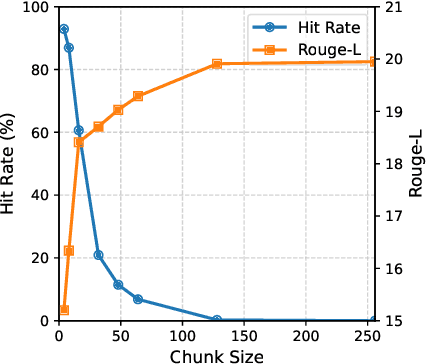


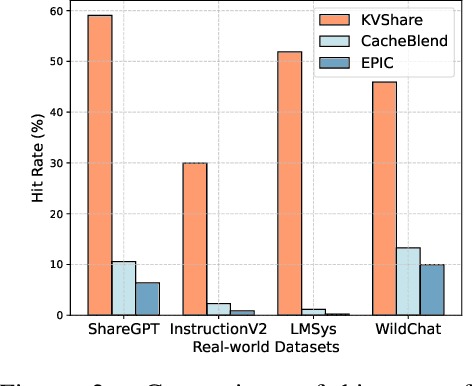
Abstract:This paper presents KVShare, a multi-user Key-Value (KV) Cache sharing technology based on semantic similarity, designed to enhance the inference efficiency of Large Language Models (LLMs) and Multimodal Large Language Models (MLLMs). Addressing the limitations of existing prefix caching (strict text prefix matching) and semantic caching (loss of response diversity), KVShare achieves fine-grained KV cache reuse through semantic alignment algorithms and differential editing operations. Experiments on real-world user conversation datasets demonstrate that KVShare improves KV cache hit rates by over 60%, while maintaining output quality comparable to full computation (no significant degradation in BLEU and Rouge-L metrics). This approach effectively reduces GPU resource consumption and is applicable to scenarios with repetitive queries, such as healthcare and education.
Vamba: Understanding Hour-Long Videos with Hybrid Mamba-Transformers
Mar 14, 2025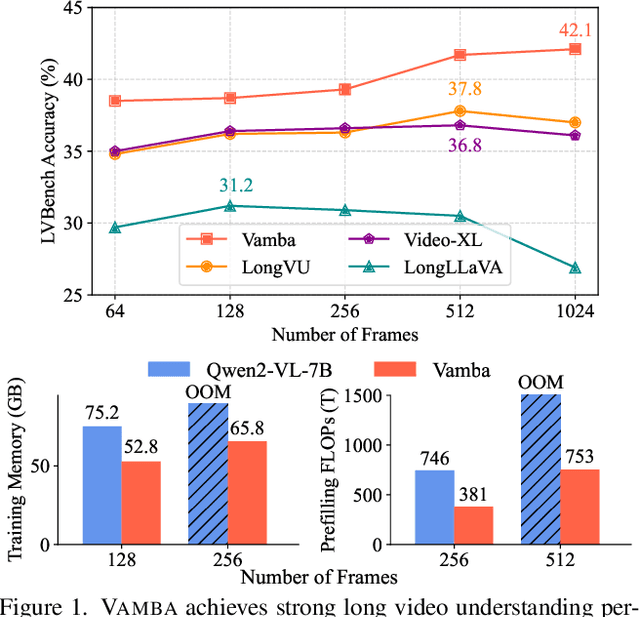

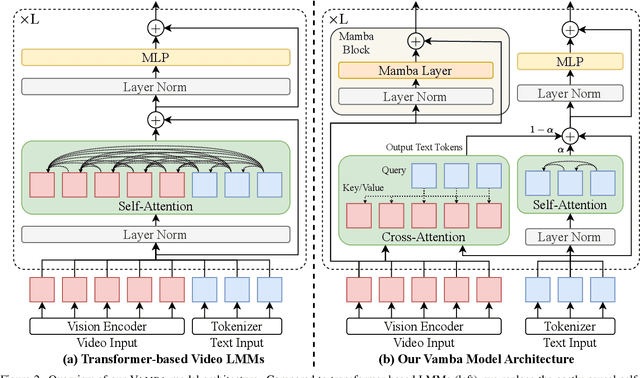
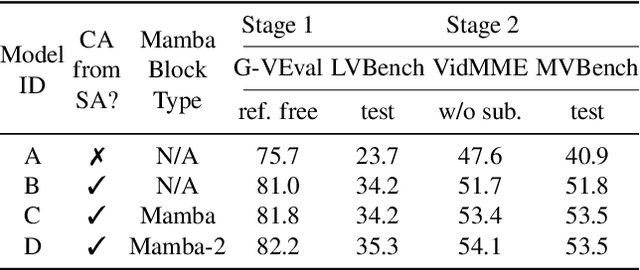
Abstract:State-of-the-art transformer-based large multimodal models (LMMs) struggle to handle hour-long video inputs due to the quadratic complexity of the causal self-attention operations, leading to high computational costs during training and inference. Existing token compression-based methods reduce the number of video tokens but often incur information loss and remain inefficient for extremely long sequences. In this paper, we explore an orthogonal direction to build a hybrid Mamba-Transformer model (VAMBA) that employs Mamba-2 blocks to encode video tokens with linear complexity. Without any token reduction, VAMBA can encode more than 1024 frames (640$\times$360) on a single GPU, while transformer-based models can only encode 256 frames. On long video input, VAMBA achieves at least 50% reduction in GPU memory usage during training and inference, and nearly doubles the speed per training step compared to transformer-based LMMs. Our experimental results demonstrate that VAMBA improves accuracy by 4.3% on the challenging hour-long video understanding benchmark LVBench over prior efficient video LMMs, and maintains strong performance on a broad spectrum of long and short video understanding tasks.
Accelerating Video Diffusion Models via Distribution Matching
Dec 08, 2024



Abstract:Generative models, particularly diffusion models, have made significant success in data synthesis across various modalities, including images, videos, and 3D assets. However, current diffusion models are computationally intensive, often requiring numerous sampling steps that limit their practical application, especially in video generation. This work introduces a novel framework for diffusion distillation and distribution matching that dramatically reduces the number of inference steps while maintaining-and potentially improving-generation quality. Our approach focuses on distilling pre-trained diffusion models into a more efficient few-step generator, specifically targeting video generation. By leveraging a combination of video GAN loss and a novel 2D score distribution matching loss, we demonstrate the potential to generate high-quality video frames with substantially fewer sampling steps. To be specific, the proposed method incorporates a denoising GAN discriminator to distil from the real data and a pre-trained image diffusion model to enhance the frame quality and the prompt-following capabilities. Experimental results using AnimateDiff as the teacher model showcase the method's effectiveness, achieving superior performance in just four sampling steps compared to existing techniques.
Long Video Diffusion Generation with Segmented Cross-Attention and Content-Rich Video Data Curation
Dec 02, 2024
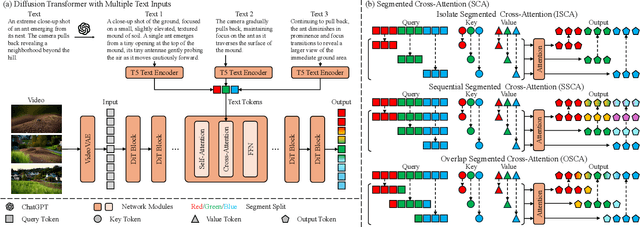


Abstract:We introduce Presto, a novel video diffusion model designed to generate 15-second videos with long-range coherence and rich content. Extending video generation methods to maintain scenario diversity over long durations presents significant challenges. To address this, we propose a Segmented Cross-Attention (SCA) strategy, which splits hidden states into segments along the temporal dimension, allowing each segment to cross-attend to a corresponding sub-caption. SCA requires no additional parameters, enabling seamless incorporation into current DiT-based architectures. To facilitate high-quality long video generation, we build the LongTake-HD dataset, consisting of 261k content-rich videos with scenario coherence, annotated with an overall video caption and five progressive sub-captions. Experiments show that our Presto achieves 78.5% on the VBench Semantic Score and 100% on the Dynamic Degree, outperforming existing state-of-the-art video generation methods. This demonstrates that our proposed Presto significantly enhances content richness, maintains long-range coherence, and captures intricate textual details. More details are displayed on our project page: https://presto-video.github.io/.
VISTA: Enhancing Long-Duration and High-Resolution Video Understanding by Video Spatiotemporal Augmentation
Dec 01, 2024



Abstract:Current large multimodal models (LMMs) face significant challenges in processing and comprehending long-duration or high-resolution videos, which is mainly due to the lack of high-quality datasets. To address this issue from a data-centric perspective, we propose VISTA, a simple yet effective Video Spatiotemporal Augmentation framework that synthesizes long-duration and high-resolution video instruction-following pairs from existing video-caption datasets. VISTA spatially and temporally combines videos to create new synthetic videos with extended durations and enhanced resolutions, and subsequently produces question-answer pairs pertaining to these newly synthesized videos. Based on this paradigm, we develop seven video augmentation methods and curate VISTA-400K, a video instruction-following dataset aimed at enhancing long-duration and high-resolution video understanding. Finetuning various video LMMs on our data resulted in an average improvement of 3.3% across four challenging benchmarks for long-video understanding. Furthermore, we introduce the first comprehensive high-resolution video understanding benchmark HRVideoBench, on which our finetuned models achieve a 6.5% performance gain. These results highlight the effectiveness of our framework.
Fleximo: Towards Flexible Text-to-Human Motion Video Generation
Nov 29, 2024



Abstract:Current methods for generating human motion videos rely on extracting pose sequences from reference videos, which restricts flexibility and control. Additionally, due to the limitations of pose detection techniques, the extracted pose sequences can sometimes be inaccurate, leading to low-quality video outputs. We introduce a novel task aimed at generating human motion videos solely from reference images and natural language. This approach offers greater flexibility and ease of use, as text is more accessible than the desired guidance videos. However, training an end-to-end model for this task requires millions of high-quality text and human motion video pairs, which are challenging to obtain. To address this, we propose a new framework called Fleximo, which leverages large-scale pre-trained text-to-3D motion models. This approach is not straightforward, as the text-generated skeletons may not consistently match the scale of the reference image and may lack detailed information. To overcome these challenges, we introduce an anchor point based rescale method and design a skeleton adapter to fill in missing details and bridge the gap between text-to-motion and motion-to-video generation. We also propose a video refinement process to further enhance video quality. A large language model (LLM) is employed to decompose natural language into discrete motion sequences, enabling the generation of motion videos of any desired length. To assess the performance of Fleximo, we introduce a new benchmark called MotionBench, which includes 400 videos across 20 identities and 20 motions. We also propose a new metric, MotionScore, to evaluate the accuracy of motion following. Both qualitative and quantitative results demonstrate that our method outperforms existing text-conditioned image-to-video generation methods. All code and model weights will be made publicly available.
Improving Multi-Subject Consistency in Open-Domain Image Generation with Isolation and Reposition Attention
Nov 28, 2024



Abstract:Training-free diffusion models have achieved remarkable progress in generating multi-subject consistent images within open-domain scenarios. The key idea of these methods is to incorporate reference subject information within the attention layer. However, existing methods still obtain suboptimal performance when handling numerous subjects. This paper reveals the two primary issues contributing to this deficiency. Firstly, there is undesired interference among different subjects within the target image. Secondly, tokens tend to reference nearby tokens, which reduces the effectiveness of the attention mechanism when there is a significant positional difference between subjects in reference and target images. To address these challenges, we propose a training-free diffusion model with Isolation and Reposition Attention, named IR-Diffusion. Specifically, Isolation Attention ensures that multiple subjects in the target image do not reference each other, effectively eliminating the subject fusion. On the other hand, Reposition Attention involves scaling and repositioning subjects in both reference and target images to the same position within the images. This ensures that subjects in the target image can better reference those in the reference image, thereby maintaining better consistency. Extensive experiments demonstrate that the proposed methods significantly enhance multi-subject consistency, outperforming all existing methods in open-domain scenarios.
 Add to Chrome
Add to Chrome Add to Firefox
Add to Firefox Add to Edge
Add to Edge